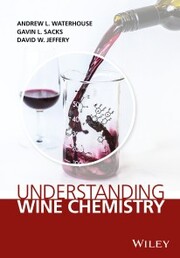-
Zusatztext
-
<p>Wine chemistry inspires and challenges with its complexity, and while this is intriguing, it can also be a barrier to further understanding. The topic is demystified in<i>Understanding Wine Chemistry</i>, Special Mention awardee in the 2018 OIV awards, which explains the important chemistry of wine at the level of university education, and provides an accessible reference text for scientists and scientifically trained winemakers alike.</p><p><i>Understanding Wine Chemistry:</i></p><ul><li>Summarizes the compounds found in wine, their basic chemical properties and their contribution to wine stability and sensory properties</li><li>Focuses on chemical and biochemical reaction mechanisms that are critical to wine production processes such as fermentation, aging, physiochemical separations and additions</li><li>Includes case studies showing how chemistry can be harnessed to enhance wine color, aroma, flavor, balance, stability and quality.</li></ul><p>This descriptive text provides an overview of wine components and explains the key chemical reactions they undergo, such as those controlling the transformation of grape components, those that arise during fermentation, and the evolution of wine flavor and color. The book aims to guide the reader, who perhaps only has a basic knowledge of chemistry, to rationally explain or predict the outcomes of chemical reactions that contribute to the diversity observed among wines. This will help students, winemakers and other interested individuals to anticipate the effects of wine treatments and processes, or interpret experimental results based on an understanding of the major chemical reactions that can occur in wine.</p>
-
-
Kurztext
-
Wine chemistry inspires and challenges with its complexity, and while this is intriguing, it can also be a barrier to further understanding. The topic is demystified in Understanding Wine Chemistry, Special Mention awardee in the 2018 OIV awards, which explains the important chemistry of wine at the level of university education, and provides an accessible reference text for scientists and scientifically trained winemakers alike. Understanding Wine Chemistry: Summarizes the compounds found in wine, their basic chemical properties and their contribution to wine stability and sensory properties Focuses on chemical and biochemical reaction mechanisms that are critical to wine production processes such as fermentation, aging, physiochemical separations and additions Includes case studies showing how chemistry can be harnessed to enhance wine color, aroma, flavor, balance, stability and quality. This descriptive text provides an overview of wine components and explains the key chemical reactions they undergo, such as those controlling the transformation of grape components, those that arise during fermentation, and the evolution of wine flavor and color. The book aims to guide the reader, who perhaps only has a basic knowledge of chemistry, to rationally explain or predict the outcomes of chemical reactions that contribute to the diversity observed among wines. This will help students, winemakers and other interested individuals to anticipate the effects of wine treatments and processes, or interpret experimental results based on an understanding of the major chemical reactions that can occur in wine.
-
-
Autorenportrait
- <p><b>Professor Andrew L. Waterhouse,</b> Department of Viticulture& Enology, University of California, Davis, USA.<br />Andrew Waterhouse received his PhD in organic chemistry from UC Berkeley, and has been a wine chemist at the University of California, Davis since 1991. He teaches wine analysis, graduate level wine chemistry, and an online introductory wine course, and is Chair of the Viticulture and Enology graduate studies program. Former graduate students and postdocs are academics, industry scientists and winemakers. His research lab has reported key wine oxidation reactions and has developed new methods to analyse wine components including those using LC-MS with isotope filtering, as well as NMR techniques. The research has focused on wine phenolics, oak compounds and oxidation products. In addition his lab has also been addressing the metabolic products of phenolics. He publishes in numerous international journals in the fields of chemistry and agriculture, and serves as a chief editor at the Journal of the Science of Food and Agriculture. See: waterhouse.ucdavis.edu.</p><p><b>Dr Gavin Sacks,</b> Department of Food Science, Cornell University, USA.<br />Gavin Sacks received his PhD in analytical chemistry from Cornell University, and following post-doctoral studies in nutritional sciences and biogeochemistry he began as a faculty in food science at Cornell in 2007. He has served as Director of Undergraduate Studies for Cornells interdepartmental Viticulture and Enology undergraduate major, in which he also teaches courses in wine analysis and in wine flavor chemistry. His research interests include the development of both low-cost and state-of-the-art approaches to analysis of odorants and other organoleptically important compounds; and applying these tools to understanding the role of plant genetics, cultural practices, and post-harvest processing on sensory attributes of foods and beverages, particularly of wine.</p><p><b>Dr David Jeffery,</b> School of Agriculture, Food and Wine, University of Adelaide, Australia.<br />David Jeffery received his PhD in synthetic organic chemistry from Flinders University, and has been involved with wine chemistry for over a decade, initially as a researcher at The Australian Wine Research Institute before transitioning to The University of Adelaide in 2010. He teaches wine chemistry to undergraduate and Master level students, delivering topics associated with stabilization, clarification, distillation, wine aroma, polyphenols, and analytical methods. He also helped to develop and deliver a free online wine education course called Wine 101x, offered on the EdX platform. Davids research areas extend to on many aspects of wine chemistry, with special interests in polyphenols and aroma compounds and their precursors. He utilizes his expertise in synthetic organic chemistry and natural product isolation, purification and characterization, along with experience in developing and applying analytical methods, to improve understanding of grape and wine chemistry, particularly in relation to chemical composition and quality.</p>
Detailansicht
Understanding Wine Chemistry
eBook - SCI (Society of Chemical Industry)
ISBN/EAN: 9781118730713
Umbreit-Nr.: 9512870
Sprache:
Englisch
Umfang: 472 S., 13.04 MB
Format in cm:
Einband:
Keine Angabe
Erschienen am 06.06.2016
Auflage: 1/2016
E-Book
Format: PDF
DRM: Adobe DRM


